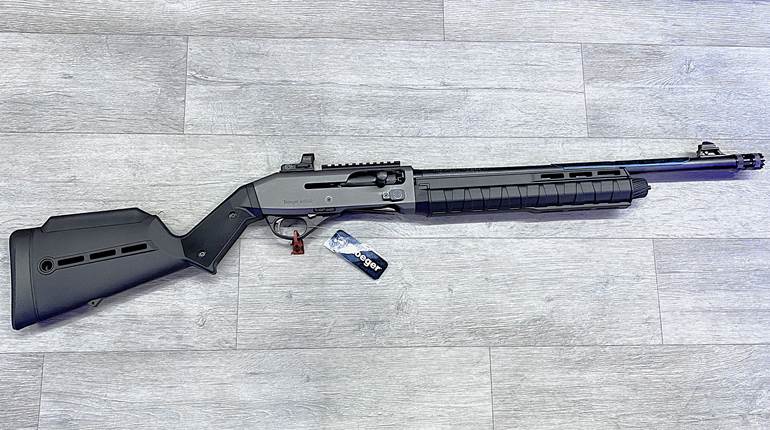
Would you like a shotgun that will shoot a million rounds and keep going? Caesar Guerini says its new Invictus will. Derived from the Latin word meaning “unconquerable” or “invincible,” the Invictus has several features that may indeed keep it around even when we’re using ray guns to break clays.
The Invictus is a slim and sleek over-under shotgun, despite its traditional Purdey-style sliding underbolt, with the action measuring 2½" from bottom to top. At the heart of the million-round system are replaceable cams that join the barrels to the action and a special plate that mates with the barrels opposite the sliding underbolt. It is the cams, one on each side of the barrels, and the “Invictus Block,” that make the action-to-barrel joint so durable. In addition, the action is wider to provide more bearing surface, which enables the sliding underbolt to extend the full width of the barrels and add strength to the action/barrel connection.
 Many Italian-made over-unders’ barrels pivot using trunnions that engage slots in the sides of the barrels. Most are replaceable, often by the user. Nevertheless, traditional trunnions are on the sides of the action. Guerini reverses that by locating the trunnions—in this case called “cams”—on the barrels to engage slots machined into the sides of the action. Replaceable, the cams offer a slightly larger pivoting surface, adding to durability.
Many Italian-made over-unders’ barrels pivot using trunnions that engage slots in the sides of the barrels. Most are replaceable, often by the user. Nevertheless, traditional trunnions are on the sides of the action. Guerini reverses that by locating the trunnions—in this case called “cams”—on the barrels to engage slots machined into the sides of the action. Replaceable, the cams offer a slightly larger pivoting surface, adding to durability.
When any double gun is fired, the action attempts to open as the barrels flex and whip under the pressures of ignition. Guerini has modified the Purdey bolt by adding its own take on the “block,” which is a gold-colored plate, into the bottom of the action. 
Although the forces of firing would seem to wear out a double gun, in fact it is often the owner closing the gun who creates the most wear. The British advise, “Just close it.” Seldom do guns need to be slammed shut, but day-in-day-out shooters are observed doing just that. During a period of years with heavy use, the hinging and bolting become loose, and the barrels become “off the face” (i.e. they no longer fit tightly against the action face), causing even more damage as the shotshells recoil within the chamber, adding to the stress on the action.
Ceasar Guerini President Wes Lang said, “It is very difficult to get barrels precisely back on face, but with our Invictus system the cams are changed, and then the ‘block’ is replaced with another larger, precisely fitted block that pushes the barrels back on face.” It’s a system that high-volume shooters can appreciate.
At the 16-yd. fitting plate, we found this particular Invictus shot about 4½" high and 4" left for the tester. Most clay guns are made to place the pattern high so that targets never disappear beneath the barrels. For sporting clays, however, some find that a shade too high, which is why it is sometimes rectified with the judicious use of sandpaper, an adjustable comb, etc.
More telling was the efficiency with which the Invictus broke a wide variety of clay targets. We passed the gun around to five experienced shooters, and all spoke favorably of it. One especially noted the excellent trigger pulls. In designing the Invictus, Guerini engineers incorporated redesigned hammers with tighter tolerances and different geometry. They also specified plating them with an industrial chrome that has a low coefficient of friction, thereby speeding up lock time.
We did find the top lever tough to open, but that goes to the tightness of any new double gun and is a characteristic that will work itself in with use over time. The safety/barrel selector is traditional Italian with the right-to-left sliding selector in the safety catch. Moving the selector to the left exposes one red-colored dot, indicating the bottom barrel will fire first. Moved right, two red dots become visible, and the top barrel fires first. Although hunters seldom use barrel selectors, sporting clay shooters use them repeatedly during a round, and this is the simplest and most direct system. The inertia-style trigger pulls for the second barrel are slightly heavier than those for the first, as they should be to prevent doubling; the recoil from the first shot sets the second barrel.
The test gun was stocked in very attractive, straight-grained oil-finished European walnut with fine 24-l.p.i. checkering, and the wood-to-metal fit is excellent. The fore-end release is an Anson rod that is far easier to manipulate than the more common spring latch in the center of the fore-end. Guerini sets off its fore-ends with a small tear-drop silver inlay that provides a touch of class. The barrels are deeply blued, the side ribs are ventilated to aid cooling; the top rib tapers from about 3/8" at the breech to 5/16" at the muzzle. The front bead was sheared off in shipping, but none of the testers noticed it was missing.
The action is coin-silver finished with laser engraving that is somewhat ordinary if not superfluous, but then one does not purchase such a shotgun for the engraving, but rather for the performance. The Caesar Guerini Invictus will be grinding clays by the thousands for quite some time.
After all, it’s made to break a million, then go in for a tune up.






































